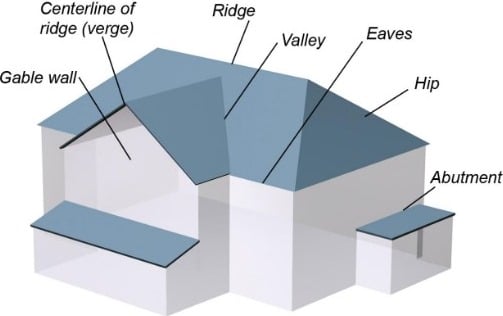24 Different Components used for Pitched Roof Construction
What is Pitched Roof?
Pitched roof is a type of roof which is provided with some slope as structure covering. We know that the roofs are generally provided at top to cover and protect the structure from different weather conditions. Pitched roofs are generally used where rainfall is heavy. If buildings are constructed with some limited width, then also we can go for pitched roofs.
Components or Elements of Pitched Roofs
Following are the elements of pitched roofs:

1. Span
Span of roof is the clear distance between the two supports on which roof is positioned by some other elements.
2. Ridge
The apex of the angle which is developed at top by the inclined surfaces at the top of slope.
3. Rise
The vertical distance or height of top of ridge from wall plate is called as rise.
4. Wall plates
Wall plates are provided at top of wall or supports. And these are generally made of wood and are used to fix the common rafters.
5. Pitch
Pitch is nothing but slope of roof with the horizontal plane and is calculated as the ration of rise to span.
6. Eaves
The bottom edge of sloped roof surface is called as eaves from which rain water is drops down during raining.
7. Hip
Hip is a place where two sloping surfaces meet, where exterior angle is more than 180o.
8. Hipped end
At the end of a roof sloped triangular surface is formed which is called as hipped end.
9. Valley
It is also a place where two sloping surfaces intersects but the exterior angle is less than 180.
10. Verge
Verge is the edge of gable roof which runs between ridge and eaves.
11. Ridge board
Ridge board is a wooden member which is provided long the ridge lie or apex of the roof. Common rafters are supported by this ridge board. This is also called as ridge beam or ridge piece.
12. Common Rafters
Common rafters are wooden members fixed to the ridge board perpendicularly. They run from ridge to the eaves. These are fixed to the purlins at intermediate points. Batten or boarding’s are supported by this rafter. In general, the spacing between rafters is 30 to 45 cm.

13. Purlins
Purlins are wooden or steel members supported by truss or wall. If the span is large they are used to support the common rafters.
14. Hip rafters
These rafters are provided at the hip end. And they run diagonally from ridge to the corners of the wall.
15. Valley rafters
Valley rafters run diagonally from ridge to the eaves. They are provided in sloping positions to bear support valley gutters. The ends of purlins and jack rafters will receive by the valley rafters.
16. Jack rafters
The rafters run from hip to the valley are called as jack rafters and usually they are short in length.
17. Eaves board
The ends of lower most roof covering materials are rests on eaves board. It is made of wood and usually 25mm x 25mm thickness and width. It is placed at the feet of common rafters.
18. Barge board
To hold the verge formed by the common rafters a wooden board is used which is called as barge board.
19. Post plate
Post plate is similar to wall plate. Post plates are parallel to the face of the wall and run continuous. Post plates provide support for the rafters.
20. Battens
Battens are usually made of wood and they are nailed to the rafters to give supports for the roof covering material.
21. Template
Template is a masonry block made of concrete or stone which is placed under the truss to provide larger load area of the wall.
22. Boarding’s
Boarding’s are similar to battens and these are also used to give support for the roof covering material by nailing them to the rafters.
23. Truss
Truss is frame which consists of triangles and designed to support the roof tops.
24. Cleats
To support the purlins, short sections of steel or wood are fixed to the rafters and these sections are called as Cleats.

No comments:
Post a Comment